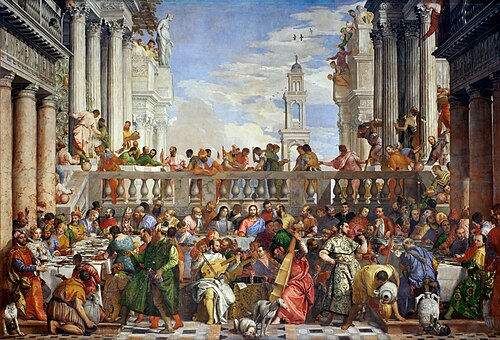The Wedding at Cana
| The Wedding Feast at Cana | |
|---|---|
 |
|
| Artist | Paolo Veronese |
| Year | 1563 |
| Medium | Oil on canvas |
| Dimensions | 6.77 m × 9.94 m (267 in × 391 in) |
| Location | Louvre Museum, Paris |
The Wedding Feast at Cana (1563), by the Italian artist Paolo Veronese (1528–88), is a representational painting that depicts the biblical story of the Marriage at Cana, at which Jesus converts water to wine (John 2:1–11). Executed in the Mannerist style (1520–1600) of the late Renaissance, the large-format (6.77m × 9.94m) oil painting comprehends the stylistic ideal of compositional harmony, as practised by the artists Leonardo, Raphael, and Michelangelo.
The art of the High Renaissance (1490–1527) emphasized human figures of ideal proportions, balanced composition, and beauty, whereas Mannerism exaggerated the Renaissance ideals — of figure, light, and colour — with asymmetric and unnaturally elegant arrangements achieved by flattening the pictorial space and distorting the human figure as an ideal preconception of the subject, rather than as a realistic representation.
The visual tension among the elements of the picture and the thematic instability among the human figures in The Wedding Feast at Cana derive from Veronese's application of technical artifice, the inclusion of sophisticated cultural codes and symbolism (social, religious, theologic), which present a biblical story relevant to the Renaissance viewer and to the contemporary viewer. The pictorial area (67.29 m2) of the canvas makes The Wedding Feast at Cana the most expansive picture in the paintings collection of the Musée du Louvre.
At Venice, on 6 June 1562, the Black Monks of the Order of Saint Benedict (OSB) commissioned the painter Paolo Veronese to realise a monumental painting (6.77m×9.94m) to decorate the far wall of the monastery's new refectory, designed by the architect Andrea Palladio, at the Basilica of San Giorgio Maggiore, on the eponymous island. In their business contract for the commission of The Wedding Feast at Cana, the Benedictine monks stipulated that Veronese be paid 324 ducats; be paid the costs of his personal and domestic maintenance; be provided a barrel of wine; and be fed in the refectory.
...
Wikipedia
